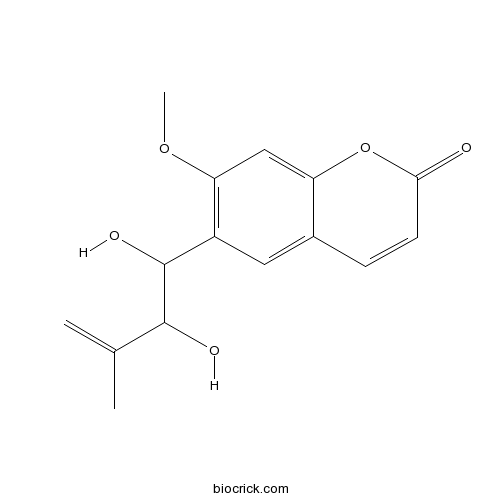ThamnosmoninCAS# 60094-90-8 |

Quality Control & MSDS
3D structure
Package In Stock
Number of papers citing our products

| Cas No. | 60094-90-8 | SDF | Download SDF |
| PubChem ID | 312089 | Appearance | Powder |
| Formula | C15H16O5 | M.Wt | 276.28 |
| Type of Compound | Coumarins | Storage | Desiccate at -20°C |
| Solubility | Soluble in Chloroform,Dichloromethane,Ethyl Acetate,DMSO,Acetone,etc. | ||
| Chemical Name | 6-(1,2-dihydroxy-3-methylbut-3-enyl)-7-methoxychromen-2-one | ||
| SMILES | CC(=C)C(C(C1=C(C=C2C(=C1)C=CC(=O)O2)OC)O)O | ||
| Standard InChIKey | PMZIJDMODGMWOR-UHFFFAOYSA-N | ||
| Standard InChI | InChI=1S/C15H16O5/c1-8(2)14(17)15(18)10-6-9-4-5-13(16)20-11(9)7-12(10)19-3/h4-7,14-15,17-18H,1H2,2-3H3 | ||
| General tips | For obtaining a higher solubility , please warm the tube at 37 ℃ and shake it in the ultrasonic bath for a while.Stock solution can be stored below -20℃ for several months. We recommend that you prepare and use the solution on the same day. However, if the test schedule requires, the stock solutions can be prepared in advance, and the stock solution must be sealed and stored below -20℃. In general, the stock solution can be kept for several months. Before use, we recommend that you leave the vial at room temperature for at least an hour before opening it. |
||
| About Packaging | 1. The packaging of the product may be reversed during transportation, cause the high purity compounds to adhere to the neck or cap of the vial.Take the vail out of its packaging and shake gently until the compounds fall to the bottom of the vial. 2. For liquid products, please centrifuge at 500xg to gather the liquid to the bottom of the vial. 3. Try to avoid loss or contamination during the experiment. |
||
| Shipping Condition | Packaging according to customer requirements(5mg, 10mg, 20mg and more). Ship via FedEx, DHL, UPS, EMS or other couriers with RT, or blue ice upon request. | ||
| Targets | P-gp |

Thamnosmonin Dilution Calculator

Thamnosmonin Molarity Calculator
| 1 mg | 5 mg | 10 mg | 20 mg | 25 mg | |
| 1 mM | 3.6195 mL | 18.0976 mL | 36.1952 mL | 72.3903 mL | 90.4879 mL |
| 5 mM | 0.7239 mL | 3.6195 mL | 7.239 mL | 14.4781 mL | 18.0976 mL |
| 10 mM | 0.362 mL | 1.8098 mL | 3.6195 mL | 7.239 mL | 9.0488 mL |
| 50 mM | 0.0724 mL | 0.362 mL | 0.7239 mL | 1.4478 mL | 1.8098 mL |
| 100 mM | 0.0362 mL | 0.181 mL | 0.362 mL | 0.7239 mL | 0.9049 mL |
| * Note: If you are in the process of experiment, it's necessary to make the dilution ratios of the samples. The dilution data above is only for reference. Normally, it's can get a better solubility within lower of Concentrations. | |||||

Calcutta University

University of Minnesota

University of Maryland School of Medicine

University of Illinois at Chicago

The Ohio State University

University of Zurich

Harvard University

Colorado State University

Auburn University

Yale University

Worcester Polytechnic Institute

Washington State University

Stanford University

University of Leipzig

Universidade da Beira Interior

The Institute of Cancer Research

Heidelberg University

University of Amsterdam

University of Auckland

TsingHua University

The University of Michigan

Miami University

DRURY University

Jilin University

Fudan University

Wuhan University

Sun Yat-sen University

Universite de Paris

Deemed University

Auckland University

The University of Tokyo

Korea University
- Beta-D-glucopyranosiduronic acid
Catalog No.:BCN3251
CAS No.:60092-34-4
- Sodium taurochenodeoxycholate
Catalog No.:BCN8152
CAS No.:6009-98-9
- Confluentic acid
Catalog No.:BCN4105
CAS No.:6009-12-7
- (1)Benzopyrano(3,4-b)furo(2,3-h)(1)benzopyran-6(12H)-one, 1,2,-dihydro-5-hydroxy-8,9-dimethoxy-2-(1-methylethenyl)-, (R)-
Catalog No.:BCN8538
CAS No.:60077-62-5
- Vogeloside
Catalog No.:BCN6737
CAS No.:60077-47-6
- Secologanic acid
Catalog No.:BCN8214
CAS No.:60077-46-5
- Bay 65-1942 HCl salt
Catalog No.:BCC1409
CAS No.:600734-06-3
- Bay 65-1942 free base
Catalog No.:BCC1408
CAS No.:600734-02-9
- N-Demethylechitamine
Catalog No.:BCN4104
CAS No.:60048-88-6
- GL3
Catalog No.:BCN8180
CAS No.:60037-39-0
- Alizarin 2-methyl ether
Catalog No.:BCN3480
CAS No.:6003-11-8
- BOC-L-6-HYDROXYNORLEUCINE
Catalog No.:BCN2360
CAS No.:77611-37-1
- Isosativan
Catalog No.:BCN4106
CAS No.:60102-29-6
- Petasitenine
Catalog No.:BCN2113
CAS No.:60102-37-6
- Baimantuoluoside C
Catalog No.:BCN8009
CAS No.:60124-17-6
- 3-(2-Hydroxyphenyl)-2-propenal
Catalog No.:BCN4107
CAS No.:60125-23-7
- Paniculoside I
Catalog No.:BCN4108
CAS No.:60129-63-7
- Paniculoside II
Catalog No.:BCN4109
CAS No.:60129-64-8
- Paniculoside III
Catalog No.:BCN7503
CAS No.:60129-65-9
- Pterodondiol
Catalog No.:BCN4110
CAS No.:60132-35-6
- Ercalcitriol
Catalog No.:BCC1556
CAS No.:60133-18-8
- Cucurbitacin S
Catalog No.:BCN2676
CAS No.:60137-06-6
- Coulteropine
Catalog No.:BCN7420
CAS No.:6014-62-6
- Cephaelin dihydrobromide
Catalog No.:BCC8142
CAS No.:6014-81-9
Modulation of P-glycoprotein activity by acridones and coumarins from Citrus sinensis.[Pubmed:17236173]
Phytother Res. 2007 Apr;21(4):386-90.
Bioguided fractionation of the roots of Citrus sinensis (Rutaceae) led to the isolation and identification of five coumarins, namely, clausarin, suberosin, poncitrin, xanthyletin and Thamnosmonin, seven acridones, namely, acrimarine B, 2-methoxycitpressine I, citpressine I, buntanine, acrimarine E, honyumine and acrimarine C, and one terpenoid, namely, limonin. Among these compounds, clausarin, 2-methoxycitpressine I and acrimarine E inhibited P-glycoprotein-mediated drug efflux in K562/R7 human leukemic cells over-expressing P-glycoprotein.
Alkaloids and coumarins of Thamnosma montana.[Pubmed:948238]
Lloydia. 1976 Mar-Jun;39(2-3):134-40.
From the turpentine broom, Thamnosma montana, four alkaloids and three coumarins were isolated and characterized. Skimmianine (5), N-methyl-acridone (4) and 5-(3'-methyl-2',3'-dihydroxybutanyl)-8-methoxypsoralen (1) were obtained previously from T. montana. Robustine (2) is reported from a Thamnosma species for the first time and acridone (6), Thamnosmonin (9), and thamontanin (14) are reported from a natural source for the first time. Evidence for the structures of the new isolates is presented.
Two new coumarin glucosides from the roots of Angelica apaensis and their anti-platelet aggregation activity.[Pubmed:17703728]
Arch Pharm Res. 2007 Jul;30(7):799-802.
Two new coumarin glucosides, 11-O-beta-D-glucopyranosyl Thamnosmonin (1) and 12-O-beta-D-glucopyranosyl gosferol (2), were isolated from the roots of Angelica apaensis. Their structures were elucidated spectroscopically. Both compounds showed weak inhibitory effects on rabbit platelet aggregation induced by PAF, AA and APD.


